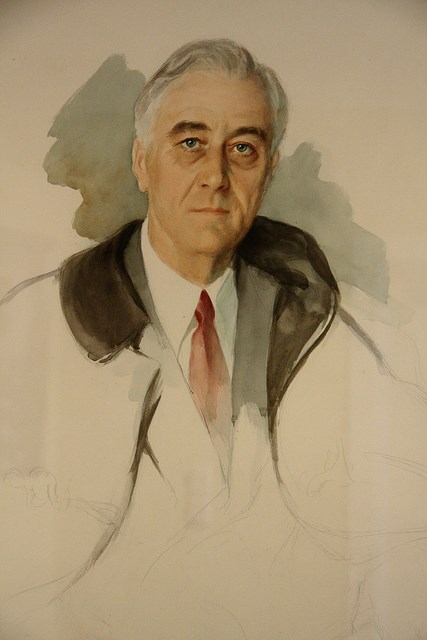Last updated: April 20, 2020
Article
Franklin D. Roosevelt's Enduring Memorial

Courtesy Roosevelt’s Little White House Historic Site
President Franklin Delano Roosevelt died unexpectedly from a cerebral hemorrhage on April 12, 1945 at Warm Springs, Georgia. At the time of his collapse, he was sitting for a portrait by the Russian-born artist Elizabeth Shoumatoff. During the sitting, FDR felt an intense pain at the back of his neck and slumped forward in his chair. He was then carried into his bedroom where he died at 3:35 pm.
Perhaps no sitting U.S. President was more active in designing his memorial legacy than Franklin Delano Roosevelt. By his second term in office, FDR was planning the presidential library and the preservation of his home—gifts to the people of the United States. He also expressed his wish to be buried in the rose garden at his family home in Hyde Park, and even outlined the details for a simple monument to mark his grave.
During the later years of his life, FDR designed what would become the tangible monuments of his legacy. Under his influence, Congress enacted legislation in 1939 to create the Franklin D. Roosevelt Library and Museum. That same year, FDR deeded 16 acres to the United States government for the nation’s first presidential library. Designed by Roosevelt and built with private funds, the library was completed in 1940 and became a model for all future presidents.
Three years later in November 1943, Secretary of the Interior Harold Ickes accepted a deed from FDR and Eleanor Roosevelt for the family home and 33 surrounding acres. On January 27, 1944, this property was designated the Home of Franklin D. Roosevelt National Historic Site. It opened to the public on the first anniversary of the president’s death in 1946. More than half a million people visited annually during the immediate years following his death.

NPS Photo
President Roosevelt made his last journey from Warm Springs on the morning of April 13, 1945. His bronze coffin, covered by the American flag, followed a procession from the Little White House between double ranks of 2,000 servicemen en route to the funeral train for Washington. The roll of muffled drums added a solemn mood to the slow-moving cortege, which paused momentarily where all of the patients of his infantile paralysis Foundation were assembled.
The train moved slowly throughout the night, passing stations filled with silent crowds gathered in reverence to watch as the President passed by. At Union Station, the procession continued with full military escort along Pennsylvania Avenue to the White House for a funeral service in the East Room.
That evening, the funeral train embarked on the final length of the journey. In the rose garden at Hyde Park, three hundred people waited in silence on the morning of April 15. The approaching sound of Chopin’s “Funeral March,” performed by the West Point band, signified the horse-drawn caisson was climbing the hillside through the woods toward the President’s final resting place.
The monument marking FDR’s grave was executed to the president’s design by the Vermont Marble Company in Proctor, Vermont. For more than a century, Vermont marble was used in the construction of important public buildings and monuments, including many of the nation’s finest structures—the Jefferson Memorial, the U.S. Supreme Court Building, and eventually the United Nations headquarters in New York City.
FDR specified that a plain white marble monument without carving or decoration be placed at his grave, situated east and west, measuring 8 feet long, 4 feet wide, and 3 feet high with a base extending 2 feet around the perimeter. The memorial stone was manufactured to President Roosevelt’s design and installed in fall of 1945. According to the President’s wishes, Mrs. Roosevelt was interred here also upon her death in 1962.
